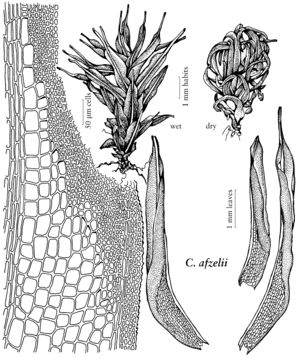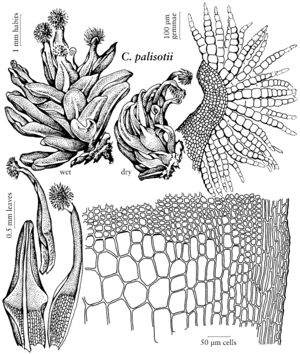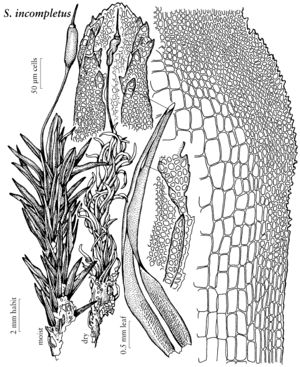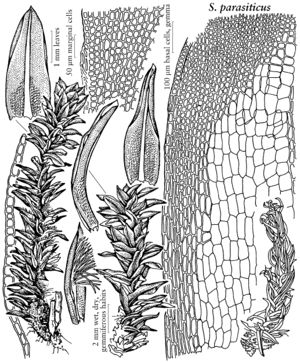Plants small to medium-sized, mostly erect [prostrate and with ascending branches], in tufts, cushions, or gregarious, rarely single or in tufts of a few; dark green to yellowish-brown stems. Stems simple or forked; central strand absent; rhizoids brown to red or dark purple, scanty to numerous, sometimes abundant and conspicuous; axillary hairs 2 to many per axil, proximal cells short and colored, or undifferentiated. Leaves often slightly to strongly dimorphic, mostly variously contorted when dry, straight and erect-ascending when moist, teniolae (intramarginal files of differentiated cells) present (in some Calymperes) or absent; proximal portion of leaves commonly sheathing, including usually conspicuous areas of smooth, enlarged, hyaline, internally and externally porose cells (cancellinae); distal portion of leaves oblong to ligulate, lanceolate, acuminate, or narrowly long-linear; margins of distal lamina mostly thickened and toothed, sometimes bordered entirely or in part with elongate hyaline cells; costa single, strong, percurrent to excurrent, in cross-section showing a median row of guide cells with abaxial and adaxial bands of stereid cells (the ad and abaxial bands of cells rarely thin-walled and parenchyma-like); medial cells of distal lamina mostly isodiametric, rarely transversely elongate, mostly variously papillose. Specialized asexual reproduction common by seriate-multicellular, fusiform-clavate to filiform gemmae, borne mostly adaxially on apices of often highly modified leaves. Sexual condition mostly dioicous, rarely monoicous; perigonia axillary, gemmiform, with highly reduced leaves; perichaetia terminal but quickly overtopped by innovations and then appearing lateral, leaves few, scarcely different from cauline leaves. Seta single, yellow to red, mostly elongate, smooth, erect. Capsule erect, mostly exserted, rarely immersed, yellowish to brown, mostly cylindric, smooth; stomata scanty, on neck, phaneropore; annulus differentiated in several rows of cells; operculum rostrate; peristome single, often vestigial or absent, teeth 16, variously papillose on external surface, mostly smooth on internal surface, with weak transverse bars. Calyptra cucullate and deciduous or rarely conic-mitrate, sometimes clasping the seta below the capsule and persistent and the spores then escaping through vertical fissures in the calyptra, naked, smooth or papillose, sometimes plicate. Spores spherical, mostly granular-papillose.
Distribution
Worldwide, mostly tropical and subtropical regions
Discussion
Genera 3, species ca. 150 (2 genera, 11 species in the flora).
The Calymperaceae are defined by clasping leaf bases with cancellinae, absence of stem central strand, usually thickened and toothed leaf margins, mainly tropical-subtropical range, corticolous habitat, and common production of uniseriate leaf-tip gemmae. Plants of the family are specialized for water capture and retention by their sheathing leaf bases, and the large, empty, porose cells of their cancellinae. The habitat is typically on bark but many taxa occur primarily on decaying wood, rock, and soil. Our taxa occur almost exclusively in the southeastern United States.
Selected References
Lower Taxa
Illustrations
Key
| 1 | Plants with sporophytes | > 2 |
| 1 | Plants without sporophytes | > 3 |
| 2 | Calyptra deciduous, cucullate, not clasping the seta, without vertical fissures. | Syrrhopodon |
| 2 | Calyptra persistent, enclosing the capsule and clasping the seta proximally, with vertical fissures | Calymperes |
| 3 | Leaves bordered entirely or in part with elongate hyaline cells. | Syrrhopodon |
| 3 | Leaf margins without elongate hyaline cells | > 4 |
| 4 | Teniolae (intramarginal files of differentiated cells) present at leaf shoulders. | Calymperes |
| 4 | Teniolae absent | > 5 |
| 5 | Leaves 4-8 mm; margins coarsely toothed and multistratose distally; gemmae adaxial on leaf apex. | Syrrhopodon |
| 5 | Leaves 1-3 mm; margins entire and 1- to 2-stratose distally; gemmae borne circling apex of excurrent costa. | Calymperes (Calymperes tenerum) |




